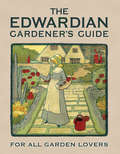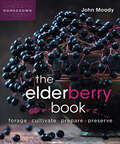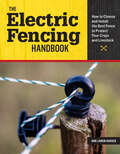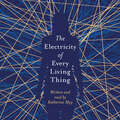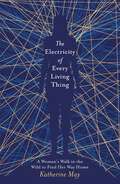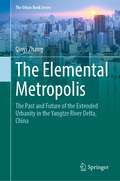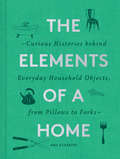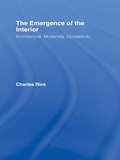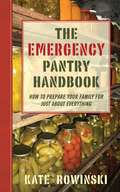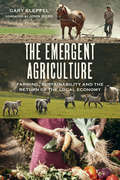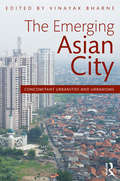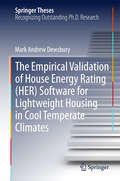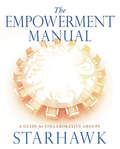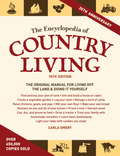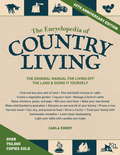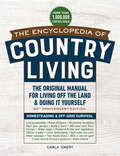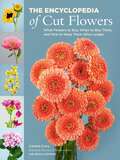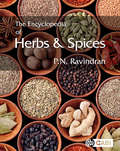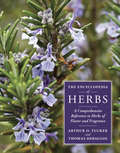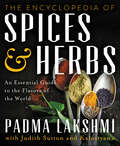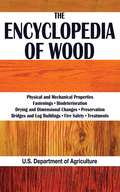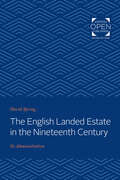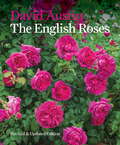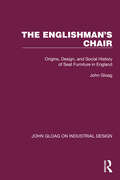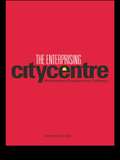- Table View
- List View
The Edwardian Gardener's Guide
by Twigs WayIt is Edwardian England, and a delightful flower garden and fruitful allotment are matters of personal pride, boons for the dinner table, and even 'important acts of local patriotism'. The Edwardian Gardener's Guide selects nuggets of wisdom from the best-selling One & All garden books, originally published in 1913. In these short booklets, the foremost agricultural and horticultural writers of the period revealed fashions in gardening styles, the best seasonal plants, how to enhance food production and now best to lay out adventurous rockeries, ferneries and grottoes. Packed with charming contemporary advertisements and color illustrations, this handbook gives a glimpse of the pre-First World War 'golden era' of British gardening. With an introduction by garden historian, Twigs Way.
The Elderberry Book: Forage, Cultivate, Prepare, Preserve (Homegrown City Life)
by John MoodyYour go-to guide for everything from cultivation to wine-making with one of humanity's oldest plant friendsSpanning history and geography, The Elderberry Book takes you on an adventure, deepening your appreciation of a plant that has played a crucial role across the world for thousands of years. Through this fun, inspirational, and educational resource, discover:Elderberry's amazing historyCultivating and foraging, from the balcony to the backyardVarious traditional food and medicine preparationsSimple wine-making techniquesTraditional crafts and tools.This is the definitive guide to the many uses of elderberry. No matter where you are, one of humankind's oldest plant friends can provide you with anything from syrup, to wine, to dyes, to so much more!Once a staple in homes across the world, and found along every highland, highway, and hedgerow, the forgotten elderberry is making a comeback. Its popularity as medicine is surging, its choice as an edible landscaping plant is growing, and its use for wine-making and crafts is being rediscovered.
The Electric Fencing Handbook: How to Choose and Install the Best Fence to Protect Your Crops and Livestock
by Ann Larkin HansenUse electric fencing to protect your livestock, poultry, beehives, and garden. Portable electric fencing is key to successful rotational grazing, while permanent electric fencing effectively protects gardens and orchards and secures large pastures. Through clear instructions accessible to everyone, you’ll learn when to use these methods or a combination of the two, plus how to plan for, build, and maintain your electric fencing. This crucial tool is cost effective and versatile, but veteran farmer and author Ann Larkin Hansen also explains what not to do with an electric fence.
The Electricity of Every Living Thing: A Woman's Walk in the Wild to Find Her Way Home
by Katherine MayLast summer, Katherine May was approaching 40, feeling overwhelmed by motherhood and lacking connection with others, lost in a world of inundation and expectation. She had always felt different but this feeling was new. She wanted to get out, get free and find herself again - and so set about walking the rugged 450 mile South West Coast Path. However, this journey uncovers more than she ever imagined. By chance, en route to the walk, Katherine hears a radio show and the guests are speaking about Asperger's Syndrome. Things begin to fall into place - could this explain the white-outs, the excruciating confusion around social contact, the electric feeling of every living thing?After a formal diagnosis, Katherine begins to unravel this new perspective of her life. Through her physical journey comes an emotional one - of accepting who she is and moving forward. It's not just about walking or Asperger's; this is one woman's journey to feel free within herself, something that everyone can relate to.Read by Nathalie Buscombe(p) Orion Publishing Group 2018
The Electricity of Every Living Thing: From the bestselling author of Wintering
by Katherine MayFrom the bestselling author of Wintering, Katherine May, The Electricity of Every Living Thing is a life-affirming and poignant exploration of nature, and how reconnecting to wild landscapes can create peace in our unquiet minds.'A windswept tale, beautifully told' Raynor Winn, author of The Salt Path 'A manifesto for the value of difficult people. I loved it' Amy Liptrot, author of The OutrunIn August 2015, Katherine May set out to walk the 630-mile South West Coast Path. She wanted to understand why she had stopped coping with everyday life; why motherhood had been so overwhelming and isolating, and why the world felt full of inundation and expectations she can't meet. Setting her feet down on the rugged and difficult path by the sea, the answer begins to unfold.The Electricity of Every Living Thing tells the story of the year in which Katherine comes to terms with a diagnosis which shakes her to her core. It leads to a re-evaluation of her life so far - a kinder one, which finally allows her to be different rather than simply awkward, arrogant or unfeeling. The physical and psychological journeys become inextricably entwined, and as Katherine finds her way across the untameable coast, she also finds the way to herself.What readers are saying about The Electricity of Every Living Thing:'Honest and sensitive' 'The astonishing sensitivity and awareness in her writing, both about the beautiful landscapes and nature around on her walks, and in relation to her family, friends and self put paid to many outdated myths about what it is like to be autistic''Compelling and transformative. I could not put this book down so I stayed in bed and read it in one go.''Katherine has a fantastic way with words, I could read her books for hours on end, they are calming and relatable.''Read it - you won't regret it.'
The Elemental Metropolis: The Past and Future of the Extended Urbanity in the Yangtze River Delta, China (The Urban Book Series)
by Qinyi ZhangThis book provides a multi-scale reading of the spatial “elements” in which the extensive urbanity in Yangtze River Delta is constructed, and from there an imagination of a new paradigm of urbanization. The urbanization in Yangtze River Delta today is in need of a new interpretation and paradigm. The delta is a territory with city cores but it also has vast dispersed urbanization where the agricultural and non-agricultural activities and spaces are mixed and interlinked, a desakota (McGee, 1991). This book attempts to answer a basic question: what is the desakota in the Yangtze River Delta made of? The research Horizontal Metropolis led by Prof. Paola Viganò at EPFL, Switzerland focuses on the form of the contemporary city – the fragmentary spatial condition and dispersed urbanity all over the world. The study on Yangtze River delta is part of its research frame.
The Elements of a Home: Curious Histories behind Everyday Household Objects, from Pillows to Forks
by Amy AzzaritoThe Elements of a Home reveals the fascinating stories behind more than 60 everyday household objects and furnishings. Brimming with amusing anecdotes and absorbing trivia, this captivating collection is a treasure trove of curiosities.With tales from the kitchen, the bedroom, and every room in between, these pages expose how napkins got their start as lumps of dough in ancient Greece, why forks were once seen as immoral tools of the devil, and how Plato devised one of the earliest alarm clocks using rocks and water—plus so much more.• A charming gift for anyone who loves history, design, or décor• Readers discover tales from every nook and cranny of a home. • Entries feature historical details from locations all over the world, including Europe, Asia, North America, and Africa. As a design historian and former managing editor of Design*Sponge, author Amy Azzarito has crafted an engaging, whimsical history of the household objects you've never thought twice about. The result is a fascinating book filled with tidbits from a wide range of cultures and places about the history of domestic luxury.• Filled with lovely illustrations by Alice Pattullo• Perfect as a housewarming or wedding gift, or for anyone who adores interior design, trivia, history, and unique facts• Great for those who enjoyed The Greatest Stories Never Told: 100 Tales from History to Astonish, Bewilder, and Stupefy by Rick Beyer, An Uncommon History of Common Things by Bethanne Patrick and John Thompson, Encyclopedia of the Exquisite: An Anecdotal History of Elegant Delights by Jessica Kerwin Jenkins
The Emergence of the Interior: Architecture, Modernity, Domesticity
by Charles RiceTaking a radical position counter to many previous histories and theories of the interior, domesticity and the home, The Emergence of the Interior considers how the concept and experience of the domestic interior have been formed from the beginning of the nineteenth century. It considers the interior's emergence in relation to the thinking of Walter Benjamin and Sigmund Freud, and, through case studies, in architecture's trajectories toward modernism. The book argues that the interior emerged with a sense of 'doubleness', being understood and experienced as both a spatial and an image-based condition. Incorporating perspectives from architecture, critical history and theory, and psychoanalysis, The Emergence of the Interior will be of interest to academics and students of the history and theory of architecture and design, social history, and cultural studies.
The Emergency Pantry Handbook: How to Prepare Your Family for Just about Everything
by Kate Rowinski Jim RowinskiIn today’s world, anything can happen—medical emergencies, power outages, natural disasters. In less time than it takes to sign off on an insurance form, the world as we know it can be brought to a standstill. There can be no question: It’s best to be prepared. The Emergency Pantry Handbook by cooking expert and readiness enthusiast Kate Rowinski offers tips, techniques, and advice on how to keep your family safe, well-fed, and fully supplied in the event of any crisis. With simple instructions, Rowinski demonstrates how to create an emergency strategy; how to protect your house, documents, and keepsakes; and how to prepare for specific disasters. Offering a unique twist on preparation handbooks, Rowinski focuses on food storage and cooking—put simply, how to plan nutritional emergency meals and avoid “making due” on canned meats and chocolate bars. The Emergency Pantry Handbook details:· Storage techniques · Personalizing your food plan · Stockpiling, shelf life, and rotation · Pickling, canning, sprouting, and drying · Making delicious dinners out of your storage pantry Whether a disaster lasts for twenty-four hours or twenty-four weeks, The Emergency Pantry Handbook is the ultimate guide to keeping your family eating healthily and maintaining proper nutrition, even in the worst of circumstances.
The Emergent Agriculture
by Gary Kleppel John IkerdLong embraced by corporations who are driven only by the desire for profit, industrial agriculture wastes precious resources and spews millions of tons of greenhouse gases into the atmosphere each year, exacerbating climate change and threatening the very earth and water on which we depend. However, this dominant system, from which Americans obtain most of their food, is being slowly supplanted by a new paradigm.The Emergent Agriculture is a collection of fourteen thematic essays on sustainability viewed through the lens of farming. Arguing that industrial food production is incompatible with the realities of nature, science, and ethics, this lyrical narrative makes the case for a locally based food system which is: Stable in the face of economic uncertainty Resilient in the face of environmental variability Grounded in stewardship of the land, on attaching value to food and the craft involved in producing it, and on respecting the dignity of farmers, consumer,s and livestockA revolution in food production is underway. Written from the vantage point of an ecologist who is also a farmer, The Emergent Agriculture is essential reading for anyone interested in food security and the potential for growing local economies. Food for thought about the future of food.Gary Kleppel is a professor of biology at the SUNY Albany, where he focuses on sustainable agriculture, conservation-based grazing, and the ecology of human-dominated landscapes. He and his wife Pam are owners of Longfield Farm, where they produce grass-fed lamb, wool, free range chickens and eggs, and artisanal breads.
The Emerging Asian City: Concomitant Urbanities & Urbanisms
by Vinayak BharneThe Asian urban landscape contains nearly half of the planet’s inhabitants and more than half of its slum population living in some of its oldest and densest cities. It encompasses some of the world’s oldest civilizations and colonizations, and today contains some of the world’s fastest growing cities and economies. As such Asian cities create concomitant imagery – polarizations of poverty and wealth, blurred lines between formality and informality, and stark juxtapositions of ancient historic places with shimmering new skylines. This book embraces the complexity and ambiguity of the Asian urban landscape, and surveys its bewildering array of multifarious urbanities and urbanisms. Twenty-four essays offer scholarly reflections and positions on the complex forces and issues shaping Asian cities today, looking at why Asian cities are different from the West and whether they are treading a different path to their futures. Their combined narrative – spanning from Turkey to Japan and Mongolia to Indonesia - is framed around three sections: Traditions reflects on indigenous urbanisms and historic places, Tensions reflects on the legacies of Asia’s East–West dialectic through both colonialism and modernism and Transformations examines Asia’s new emerging utopias and urban aspirations. The book claims that the histories and destinies of cities across various parts of Asia are far too enmeshed to unpack or oversimplify. Avoiding the categorization of Asian cities exclusively by geographic location (south-east, Middle East), or the convenient tagging of the term Asian on selective regional parts of the continent, it takes a broad intellectual view of the Asian urban landscape as a 'both…and' phenomenon; as a series of diverse confluences – geographic, historic and political – extending from the deserts of the Persian Gulf region to the Pearl River Delta. Arguing for Asian cities to be taken seriously on their own terms, this book represents Asia – as a fount of extraordinary knowledge that can challenge our fundamental preconceptions of what cities are and ought to be.
The Empirical Validation of House Energy Rating (HER) Software for Lightweight Housing in Cool Temperate Climates
by Mark Andrew DewsburyThis book reports on the first empirical validation of "AccuRate," Australia's national benchmark software tool for house energy ratings. The validation was conducted by the University of Tasmania in collaboration with Forest and Wood Products Australia, the Australian Government, the CSIRO and industry partners. The study presented here describes the results of graphical and statistical analysis of variations observed between the measured and simulated data from three different test buildings in Launceston, Tasmania. It shows that, while the AccuRate software is well suited to modeling energy flows, there are discrepancies between the simulated and measured temperatures of the test buildings. Moreover, it highlights possible connections between the discrepancies in all zones and the outside air temperature, wind speed, global and diffuse solar radiation, and possibly the ground model. Beyond its contribution to further investigations into the ongoing improvement and calibration of the Australian NatHERS-supported AccuRate software, this book also meticulously describes the methodology used in conducting the research, which is expected to pave the way for further studies of this type.
The Empowerment Manual
by StarhawkA Transition Town group involved in preparations for peak oil and climate change; an intentional community, founded with the highest ideals; a nonprofit dedicated to social change-millions of such voluntary groups exist around the world. These collaborative organizations have the unique potential to harness their members' ideals, passions, skills, and knowledge-if they can succeed in getting along together.The Empowerment Manual is a comprehensive manual for groups seeking to organize with shared power and bottom-up leadership to foster vision, trust, accountability, and responsibility. This desperately needed toolkit provides keys to:*Understanding group dynamics*Facilitating communication and collective decision-making*Dealing effectively with difficult people.Drawing on four decades of experience, Starhawk shows how collaborative groups can generate the cooperation, efficacy, and commitment critical to success. Her extensive exploration of group process is woven together with the story of RootBound-a fictional ecovillage mired in conflict-and rounded out with a series of real-life case studies. The included exercises and facilitator toolbox show how to establish the necessary structures, ground rules, and healthy norms. The Empowerment Manual is required reading for anyone who wants to help their group avoid disagreement and disillusionment and become a wellspring of creativity and innovation.Starhawk is the author of eleven previous books including the award-winning Webs of Power. A highly influential voice for global justice and the environment, she is deeply committed to bringing the creative power of spirituality to political activism.
The Encyclopedia of Country Living, 10th Edition
by Carla EmeryNo home is complete without this one-of-a-kind encyclopedia! For more than thirty years, people have relied on the thousands of recipes, detailed how-to instructions, and personal advice provided in this definitive classic. It is the most complete source of step-by-step information about growing, processing, cooking, and preserving homegrown foods from garden, orchard, field, or barnyard. This book is so basic, so thorough, so reliable, that it deserves a place in every home whether country, city, or in between. Carla Emery started writing The Encyclopedia of Country Living in 1969 during the back-to-the-land movement of that time. She continued to add content and refine the information over the years ad the book went from a self-published mimeographed document to a book published by Bantam and then Sasquatch. The 10th Edition reflects the most up-to-date and the most personal version of the book that became Carla Emery's life work. It is the original manual of basic country skills that have proved essential and necessary for people living in the country and the city, and everywhere in between. The practical advice in this exhaustive reference tool includes how to cultivate a garden, buy land, bake bread, raise farm animals, make sausage, can peaches, milk a goat, grow herbs, churn butter, build a chicken coop, catch a pig, cook on a wood stove, and much, much more.
The Encyclopedia of Country Living, 40th Anniversary Edition: The Original Manual for Living off the Land & Doing It Yourself
by Carla EmeryThe essential resource for modern homesteading, growing and preserving foods, and raising chickens, The Encyclopedia of Country Living includes how to cultivate a garden, buy land, bake bread, raise farm animals, make sausage, can peaches, milk a goat, grow herbs, churn butter, build a chicken coop, catch a pig, cook on a wood stove, and much, much more. This comprehensive resource is the most authoritative guide available to a sustainable lifestyle and living off of the land. Carla Emery started writing The Encyclopedia of Country Living in 1969 during the back-to-the-land movement of that time. She continued to add content and refine the information over the years, and the book went from a self-published mimeographed document to a book of 928 pages.This 40th Anniversary Edition reflects the most up-to-date resource information and the most personal version of the book that became Carla Emery's life work. It is the original manual of basic country skills that have proved essential and necessary for people living in the country, the city, and everywhere in between.Carla Emery's The Encyclopedia of Country Living contains 1,000,000 words, 2,000+ recipes, and 1,500+ mail-order sources (for everything she tells you how to do, she also tells you where to get the supplies to do it). This book is so basic, so thorough, so reliable, that it deserves a place in every home.From the Trade Paperback edition.
The Encyclopedia of Country Living, 50th Anniversary Edition: The Original Manual for Living off the Land & Doing It Yourself
by Carla EmeryThis is an update of the #1 best-selling title on the Sasquatch Books list with an incredible backlist rate of sale that shows this book's ability to constantly appeal to new audiences. The Encyclopedia of Country Living is the original manual of basic skills and country wisdom for living on the land--whether it's a farm or homestead, suburb or city. Continually updated since its inception in 1969, the 50th Anniversary Edition is complete with updated resource and contact information. From craft culture to survivalists, preppers, homesteaders, urban farmers, and everyone in between there is a desire for a simpler way of life—a healthier, greener, more self-sustaining and holistic approach to modern life. The knowledge you need to survive and thrive off the grid is at your fingertips in The Encyclopedia of Country Living, the best-selling resource for the homesteading movement. With its origins in the back-to-the-land effort of the late 1960s, Carla Emery&’s landmark book has grown into a comprehensive guide to building your sustainable country escape haven, while lowering your carbon footprint in the process. The 50th anniversary edition offers up-to-date and detailed information on the fundamentals of topics like homegrown food; raising chickens, goats, and pigs; beekeeping; food preservation; mail-order supply sourcing; foraging; and much, much more (even how to deliver a baby)—everything you need to lead a self-sufficient lifestyle in the 21st century. Basic, thorough, and reliable, this book deserves a place in urban and rural homes alike.Table of Contents1 Oddments2 Introduction to Plants3 Grasses, Grains & Canes4 Garden Vegetables5 Herbs & Flavorings6 Tree, Vine, Bush & Bramble7 Food Preservation8 Introduction to Animals9 Poultry10 Goats, Cows & Home Dairying11 Bee, Rabbit, Sheep & Pig12 Appendix
The Encyclopedia of Cut Flowers: What Flowers to Buy, When to Buy Them, and How to Keep Them Alive Longer
by Calvert CraryFrom Calvert Crary and Bruce Littlefield, The Encyclopedia of Cut Flowers is a comprehensive, gorgeously visual guide that answers every question you've ever had (and a few you didn't know to ask!) about buying, caring for, and prolonging the lives of more than 140 different varieties of commonly available cut flowers.The Encyclopedia of Cut Flowers dives deep into the world of fresh-cut flowers, featuring unique entries for 143 different varieties of commonly available cut flowers that readers can buy at their local grocery store or flower market. Each flower entry offers authoritative tips for conditioning methods (eg–cut flowers should never be put near fresh fruit because fruit produces ethylene gas which will shorten the flowers' life), as well as scientific and common names, best seasons for buying (eg—lilies in spring, dahlias in summer) and fascinating facts about each bloom. An introductory section offers basic tips for styling arrangements at home, and for keeping flowers hydrated and alive for as long as possible. By the time readers are done flipping through the pages of The Encyclopedia of Cut Flowers, which features more than 150 gorgeous color photographs of flowers, they'll be experts in the field!
The Encyclopedia of Herbs & Spices
by P. N. RavindranThe Encyclopedia of Herbs and Spices provides comprehensive coverage of the taxonomy, botany, chemistry, functional properties, medicinal uses, culinary uses and safety issues relating to over 250 species of herbs and spices. These herbs and spices constitute an important agricultural commodity and are indispensable for pharmaceuticals, flavoring foods and beverages, and in the perfumery and cosmetic industries. More recently, they are increasingly being identified as having high nutraceutical potential and important value in human healthcare. An invaluable reference tool, this book: • Presents easily accessible information, including up-to-date nomenclature and taxonomy • Is beautifully illustrated with over 250 figures • Begins with an introductory chapter on the definition, classification, history, and applications of herbs and spices worldwide • Is written by a well-known authority within the field This encyclopedia is an excellent resource for researchers, students, growers and manufacturers, in the fields of horticulture, agriculture, botany, crop sciences, food science and pharmacognosy.
The Encyclopedia of Herbs: A Comprehensive Reference to Herbs of Flavor and Fragrance
by Arthur O. Tucker Thomas DeBaggioThis meticulously researched compendium provides every aspect of growing, identifying, harvesting, preserving, and using more than 500 species of herbs. Thorough profiles provide a plant's botanical name and family, whether it is an annual or perennial, its height, hardiness, light requirements, water consumption, required soil type, and pH. The often fascinating history of the plant, the chemistry of its essential oils, and its culinary, landscape, and craft uses are also included, as is advice on how to propagate. For the first edition of their work, both authors received The Gertrude B. Foster Award for Excellence in Herbal Literature from the Herb Society of America. This new edition adds important species and includes updated nomenclature.
The Encyclopedia of Spices & Herbs: An Essential Guide to the Flavors of the World
by Judith Sutton Padma LakshmiFrom the Emmy-nominated host of the award-winning Top Chef, an A-to-Z compendium of spices, herbs, salts, peppers, and blends, with beautiful photography and a wealth of explanation, history, and cooking advice.“A beautiful book by Padma Lakshmi featuring an extensive catalogue and helpful recommendations on how best to use these ingredients to create full-flavored dishes. A great resource for any chef or home cook.” -- Eric RipertAward-winning cookbook author and television host Padma Lakshmi, inspired by her life of traveling across the globe, brings together the world’s spices and herbs in a vibrant, comprehensive alphabetical guide. This definitive culinary reference book is illustrated with rich color photographs that capture the essence of a diverse range of spices and their authentic flavors. The Encyclopedia of Spices and Herbs includes complete descriptions, histories, and cooking suggestions for ingredients from basic herbs to the most exotic seeds and chilies, as well as information on toasting spices, making teas, and infusing various oils and vinegars. And no other market epitomizes Padma’s love for spices and global cuisine than where she spent her childhood—lingering in the aisles of the iconic gourmet food store Kalustyan’s, in New York City.Perfect for the holiday season and essential to any well-stocked kitchen or cooking enthusiast, The Encyclopedia of Spices and Herbs is an invaluable resource as well as a stunning and adventurous tour of some of the most wondrous and majestic flavors on earth.
The Encyclopedia of Wood
by AgricultureTimber is one of our most precious, versatile, and vulnerable resources, so using it effectively is important. Knowing your material inside and out is the first step to doing just that. Read about the structure of wood itself, from growth rings to its chemical composition. Learn wood's physical and mechanical properties, including everything from elasticity to nuclear radiation. This extensive manual includes a section on stress grading as well as thorough descriptions of which fasteners to use and when. It has information on adhesive bonding, biodeterioration, control of moisture content, preservation, fire safety, specialty treatments, and much more. The Encyclopedia of Wood is an essential resource for builders, architects, engineers, and woodworkers.
The English Landed Estate in the Nineteeth Century: Its Administration
by David SpringOriginally published in 1963. The English Landed Estate in the Nineteeth Century: Its Administration deals principally with the administration of large landed estates during the years from 1830 to 1870. The book also throws new light on the work of the Inclosure Commissioners, who, as a department of the central government, supervised agricultural improvements made by landowners who borrowed from the government and from land companies. Author David Spring argues that the British government intervened in agriculture much more than is commonly thought. In describing the hierarchy of estate management, Spring relies, wherever possible, on hitherto unused family papers and estate documents. Especially important is his material on the Dukes of Bedford and on the domestic economy and financial position of the Russell Family. The chapter titled "The Landowner," based on the seventh Duke of Bedford's correspondence with his agent, is a case study of a single estate and provides insight into the workings of a great landowner's mind. The remaining chapters, dealing with lawyers, land agents, and the Inclosure Commissioners, include other individual portraits. Among these are Christopher Haedy, the Duke of Bedford's chief agent; James Loch, king of estate agents in nineteenth-century England; Henry Morton, the Earl of Durham's land agent; and William Blamire and James Caird, two of the Inclosure Commissioners.
The English Roses: Climbing, English, Shrub, Hybrid Teas And Old Roses
by David AustinDavid Austin Roses is one of the world's leading rose nurseries. The English Roses developed there have brought the rose to a new level of beauty and strength; their ability to flower continually throughout the summer and autumn makes them one of the most durable garden flowers.In this revised and updated edition, David Austin describes how he combines the beauty and fragrance of the Old Roses with the repeat-flowering and wide colour range of the Modern Roses. David presents seven groups of classification for his roses and advises how to grow and maintain them.Featuring more than 20 new rose varieties, all with detailed descriptions and updated photography throughout, this third revised edition of The English Roses is an essential reference for all rose lovers and gardeners.
The Englishman's Chair: Origins, Design, and Social History of Seat Furniture in England
by John GloagOriginally published in 1964, The Englishman’s Chair is a history of English chairs, written as a continuous story from the 15th to the 20th Century and because of the revealing powers inherent in chair-making and design, it is also an unconventional footnote to English social history. The changes in taste, and fashion, the increase of skill, the introduction of new materials and the long battle between dignity and comfort are discussed, as is the impact that modern industrial designers have had on chair design.
The Enterprising City Centre: Manchester's Development Challenge
by Gwyndaf WilliamsThe Enterprising City Centre reveals exemplars of local partnership working, the development and delivery of realistic implementation plans, and the range of instruments available to create both an improved quality to the urban environment and enhanced commercial and cultural competitiveness of our major city centres. That this was largely delivered in Manchester within a five year period of intensive development and renewal activity amply demonstrates the value of such experience for wider dissemination.
